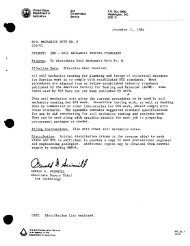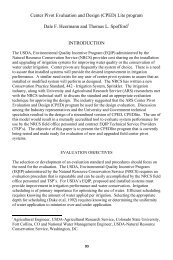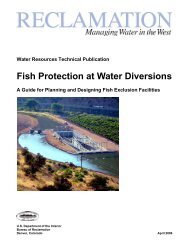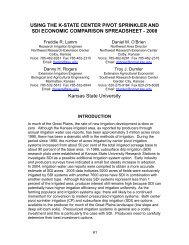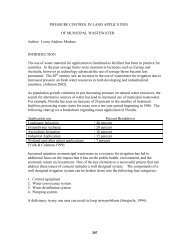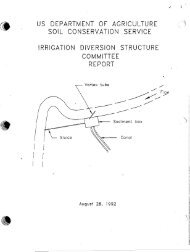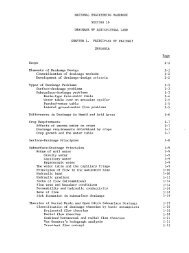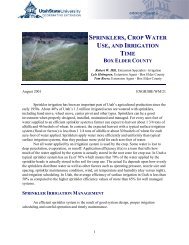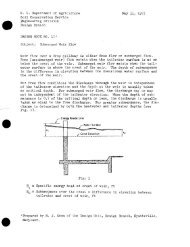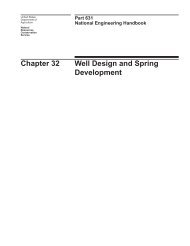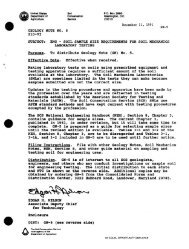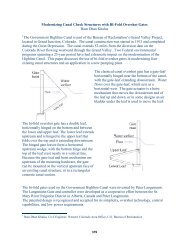Chapter 11: Sprinkle Irrigation - NRCS Irrigation ToolBox Home Page
Chapter 11: Sprinkle Irrigation - NRCS Irrigation ToolBox Home Page
Chapter 11: Sprinkle Irrigation - NRCS Irrigation ToolBox Home Page
Create successful ePaper yourself
Turn your PDF publications into a flip-book with our unique Google optimized e-Paper software.
<strong>11</strong>-45<br />
and to maintain a nearly constant load on the<br />
pumping plant. Because no variation will be needed<br />
in a rectangular area, farmers should be encouraged<br />
to relocate fences, drainage ditches, roads, and<br />
other field boundaries, where practicable, to obtain<br />
a rectangular area.<br />
Pipe lengths are generally standardized, and<br />
sprinklers on portable systems are normally spaced<br />
at 30-, 40-, and 60-ft intervals on the laterals. Furthermore,<br />
the spacing between laterals is usually at<br />
40-, 50-, 60-, and 80-ft intervals along the mainline.<br />
Since whole laterals must be operated simultaneously,<br />
the preliminary system capacity determined by<br />
equation 1 may be lower than the required capacity<br />
even on rectangular fields. However, the depth per<br />
irrigation (d) or the length of actual operating time<br />
per irrigation (f X T) can usually be adjusted to<br />
optimize the fit.<br />
On odd-shaped fields where it is sometimes necessary<br />
to operate less than the average required number<br />
of sprinklers for one or more lateral settings,<br />
the engine is throttled down to reduce the discharge.<br />
Where two or more laterals (each containing<br />
different numbers of sprinklers) are operating simultaneously,<br />
valves in the lateral lines must be used<br />
to control the pressure at the sprinklers. For most<br />
odd-shaped tracts, the number of sprinklers needed<br />
will exceed the theoretical minimum number computed,<br />
and extra equipment will be necessary to<br />
serve parts of the tract most distant from its tenter.<br />
If the design area is subdivided, the number of<br />
sprinklers required for each subdivision must be<br />
computed separately.<br />
Number of Lateral Settings.-The number of settings<br />
required for each lateral depends on the number<br />
of allowable sets per day and on the maximum<br />
number of days allowed for completing one irrigation<br />
during the peak-use period (f). The requited<br />
number of settings per lateral must not exceed the<br />
product of these two factors.<br />
If the system layout provides for at least the<br />
theoretical minimum number of sprinklers required,<br />
then the number of settings required per lateral will<br />
not exceed this allowable limit. Long, narrow, or irregularly<br />
shaped parts of a tract, however, may require<br />
additional lateral settings. Thus, more equip*<br />
ment is necessary if such areas are to be served<br />
within the allowable time period.<br />
Lateral Layout.-Figure <strong>11</strong>-30 shows the effects<br />
of topography on lateral layout. To obtain near-uni-<br />
form application of water throughout the length of<br />
a lateral, the line must be of a pipe diameter and<br />
length and follow an alignment that will result in a<br />
minimum variation in the discharge of individual<br />
sprinklers along the line. Normally this variation in<br />
discharge should not exceed 10 percent unless long<br />
term economic justification exists. Therefore, either<br />
pressure (or flow) regulation must be provided for<br />
each sprinkler or laterals must be located and pipe<br />
sizes selected so that the total losses in the line,<br />
due to both friction head and static head, will not<br />
exceed 20 percent of the average design operating<br />
pressure for the sprinklers (P,).<br />
To meet this pressure-variation criteria, it is<br />
usually necessary to lay laterals across prominsnt<br />
land slopes (fig. <strong>11</strong>-30A and B). Laid on level land<br />
or on the contour, a lateral of a given pipe size with<br />
a fixed average sprinkler-discharge rate (q,) will<br />
thus be limited only to that length in which 20 percent<br />
of P, is lost as a result of friction.<br />
Running laterals uphill should be avoided wherever<br />
possible. Where they must be used, they need<br />
to be materially shortened unless pressure or flow<br />
regulators are used. Such a lateral of a given pipe<br />
size and fixed q, is limited to that length in which<br />
the loss due to friction is equal to the difference between<br />
20 percent of Pa and the loss due to static<br />
head. For example, if the static head caused by the<br />
difference in elevation between ends of the lateral<br />
amounts to 12 percent of Pa, then the line is limited<br />
to the length in which only 8 percent of Pa is lost<br />
because of friction.<br />
Running laterals downslope is often a distinct advantage,<br />
provided the slope is fairly constant and<br />
not too steep (see fig. <strong>11</strong>-30C, D, E, and F). Be- ,<br />
cause the difference in elevation between the two<br />
ends of the line causes a gain in head, laterals running<br />
downslope may be longer than lines laid on<br />
level ground.<br />
While downslopes may permit longer laterals for<br />
a given pipe size or smaller pipe for a given length<br />
of lateral, such a layout does not usually permit<br />
split-line layout and lateral rotation about the mainline<br />
or submain. Thus labor costs may be higher.<br />
When the slope of the ground along the lateral is<br />
about equal to the slope of the friction loss, the<br />
pressure along the lateral is nearly constant. When<br />
the slope along the lateral increases for successive<br />
settings, intermediate control valves may be required<br />
to avoid building up excessive pressures and<br />
exceeding the variation limit,



